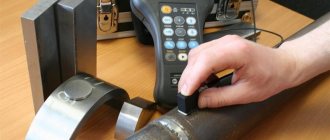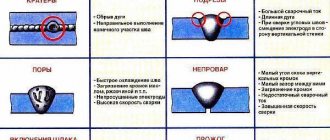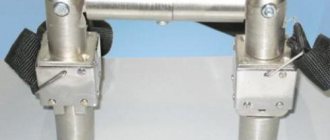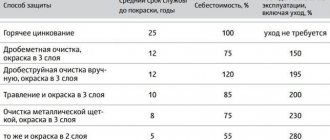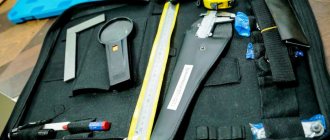Mechanical engineering parts and mechanisms, as well as tools intended for their processing, have a set of mechanical characteristics. Hardness plays a significant role among the characteristics. The hardness of metals clearly shows:
- wear resistance of metal;
- possibility of processing by cutting, grinding;
- resistance to local pressure;
- ability to cut other materials and others.
In practice, it has been proven that most of the mechanical properties of metals directly depend on their hardness.
How is hardness measured and how is it designated?
For most hardness measurement methods, the basic unit of measurement is kgf/mm2
However, you should understand that there are methods with their own unit.
The designation of hardness also depends on the method.
The letter “H” always denotes “hardness” (from the English Hardness), and then the letters indicating the determination method are indicated. The most popular designations:
- HB – Brinell method (pressing a steel ball)
- HRA - Rockwell method, A scale (diamond or steel cone indentation)
- HRB – Rockwell method, B scale
- HRC - Rockwell method, C scale
- HV – Vickers method (diamond pyramid indentation)
- HSD – Shore hardness, etc. (rebound method)
Hardness of base metals and alloys
The hardness value is measured on finished parts sent for assembly. Control is carried out for compliance with the drawing and technological process. Tables of hardness values have already been compiled for all basic materials, both in the initial state and after heat treatment.
Non-ferrous metals
The Brinell hardness of copper is 35 HB, the values of brass are 42-60 HB units, depending on its brand. For aluminum, the hardness is in the range of 15-20 HB, and for duralumin it is already 70 HB.
Black metals
The Rockwell hardness of cast iron SCH20 HRC 22, which corresponds to 220 HB. Steel: tool – 640-700 HB, stainless steel – 250 HB.
To convert from one measurement system to another, tables are used. The values in them are not true, because they are derived imperially. Not the full volume is presented in the table.
| HB | H.V. | H.R.C. | HRA | HSD |
| 228 | 240 | 20 | 60.7 | 36 |
| 260 | 275 | 24 | 62.5 | 40 |
| 280 | 295 | 29 | 65 | 44 |
| 320 | 340 | 34.5 | 67.5 | 49 |
| 360 | 380 | 39 | 70 | 54 |
| 415 | 440 | 44.5 | 73 | 61 |
| 450 | 480 | 47 | 74.5 | 64 |
| 480 | 520 | 50 | 76 | 68 |
| 500 | 540 | 52 | 77 | 73 |
| 535 | 580 | 54 | 78 | 78 |
Hardness values, even if produced by the same method, depend on the applied load. The lower the load, the higher the readings.
What are the requirements for the product to be measured?
Hardness is directly proportional to the load to determine it. High hardness – high load.
The more accurate the method, the higher the requirements for preparing the surface of the product. The surface of the product on which hardness is determined must meet a number of requirements:
- The thickness of the sample must be at least 10 times the depth of penetration of the tip after removing the main force.
- At the inspection site, it must be cleaned to a shine, be smooth and flat, and must be free of scale, rust, oil, fat and paint contamination, potholes and scratches. Roughness Ra is not more than 2.5 µm according to GOST 2789, unless there are other requirements of regulatory and technical documentation.
- The surface on which the sample “lays” on the object stage of the device must also be clean and level. Both surfaces must be parallel to each other.
- The product must be securely fastened, excluding the possibility of displacement of the sample relative to the axis of load application.
Rockwell hardness
The hardness of materials is an integrating indicator of their mechanical properties. There is an empirical correspondence between the hardness value and a number of mechanical properties (for example, compressive, tensile or bending strength).
With the development of mechanical engineering, the need arose to have general methods for measuring hardness. At the beginning of the 20th century, Professor Ludwig developed the theoretical part of the method for determining hardness with a diamond cone. In 1919, Hugh and Stanley Rockwell patented a hydromechanical device, which was named the Rockwell hardness tester.
The relevance of this device is caused by the need to use non-destructive methods of hardness control in the bearing industry. The existing Brinell (HB) method is based on measuring the indentation area of a 10 mm diameter ball.
The imprint is formed using a ball of hardened steel or tungsten carbide, which is pressed into the sample with a certain force. The Brinell method is used to determine the hardness of non-ferrous metals or low-alloy steels and is not applicable to hardened steel samples.
This is due to the fact that the working load is 3000 kgf. The ball is deformed, so the Brinell method cannot be considered a non-destructive testing method.
Rockwell hardness test method
Hardness is a characteristic of a material that is opposite to plasticity, the ability of a material to “flow” under load. The Rockwell hardness measurement technique is intended for non-destructive testing of the hardness of the least ductile materials - steels and their alloys.
The versatility of the method lies in the presence of three hardness scales, which are calibrated for measurement under one of three loads (60, 100 and 150 kgf) to work with one of the measuring heads.
A diamond cone with an angle of 120° and an apex radius of 0.2 mm or a hardened ball with a diameter of 1/16“ (1.588 mm) is used as the working body of the measuring head.
The method is based on recording the direct measurement of the depth of penetration of a solid body by a measuring head (indenter) into the sample material. The depth of the indentation characterizes the ability of the material to resist external influences without forming a roll of displaced metal around the indenter.
The Rockwell hardness unit is a dimensionless value, which is expressed in conventional units up to 100. The displacement of the indenter by 0.002 was taken as a unit of hardness.
Metal hardness according to Rockwell: table
The table was created for a visual comparison of the Rockwell and Brinell methods.
| According to Rockwell | According to Brinell | |||
| HRACone 120° load. 60 kgf | HRCone 120° loaded 150 kgf | HRB Ball Ø 1.58 mm load. 100 kgf | Diameter of printsmm | HBball Ø 10 mmload. 3000 kgf |
| 84,5 | 65 | — | 2,34 | 688 |
| 83,5 | 64 | — | 2,37 | 670 |
| 83 | 63 | — | 2,39 | 659 |
| 82,5 | 62 | — | 2,42 | 643 |
| 82 | 61 | — | 2,45 | 627 |
| 81,5 | 60 | — | 2,47 | 616 |
| 81 | 59 | — | 2,5 | 601 |
| 80,5 | 58 | — | 2,54 | 582 |
| 80 | 57 | — | 2,56 | 573 |
| 79 | 56 | — | 2,6 | 555 |
| 79 | 55 | — | 2,61 | 551 |
| 78,5 | 54 | — | 2,65 | 534 |
| 78 | 53 | — | 2,68 | 522 |
| 77,5 | 52 | — | 2,71 | 510 |
| 76 | 51 | — | 2,75 | 495 |
| 76 | 50 | — | 2,76 | 492 |
| 76 | 49 | — | 2,81 | 474 |
| 75 | 48 | — | 2,85 | 461 |
| 74 | 47 | — | 2,9 | 444 |
| 73,5 | 46 | — | 2,93 | 435 |
| 73 | 45 | — | 2,95 | 429 |
| 73 | 44 | — | 3 | 415 |
| 72 | 42 | — | 3,06 | 398 |
| 71 | 40 | — | 3,14 | 378 |
| 69 | 38 | — | 3,24 | 354 |
| 68 | 36 | — | 3,34 | 333 |
| 67 | 34 | — | 3,44 | 313 |
| 67 | 32 | — | 3,52 | 298 |
| 66 | 30 | — | 3,6 | 285 |
| 65 | 28 | — | 3,7 | 269 |
| 64 | 26 | — | 3,8 | 255 |
| 63 | 24 | 100 | 3,9 | 241 |
| 62 | 22 | 98 | 4 | 229 |
| 61 | 20 | 97 | 4,1 | 217 |
| 60 | 18 | 95 | 4,2 | 207 |
| 59 | — | 93 | 4,26 | 200 |
| 58 | — | — | 4,34 | 193 |
| 57 | — | 91 | 4,4 | 187 |
| 56 | — | 89 | 4,48 | 180 |
(*) — The presented table of correspondence between hardness on the Rockwell HRA, HRC and HRB scales and hardness on the Brinell scale is for reference only and cannot be used for applied solutions. For technical use, one should rely on data according to GOST 8.064-79 for the Rockwell scales HRA, HRC and Super-Rockwell HRN, HRT, the values in which are reduced to the reference value HRCе.
How does the Rockwell hardness scale work?
11 scales have been developed for determining hardness (A...H, K, N, T), which are designed to work in various combinations of “intendent - load”. For example, scales B, F and G are used for measuring a ball Ø 1.588 with a load on scales B, F - 60 kgf and on scale G - 150 kgf. For scales E, H and K, a Ø 3.175 mm ball with different loads is used.
The following scales are common:
- A - with a cone and a total force on the measuring head of 60 kgf (10 kgf - preliminary load plus 50 kgf - main load).
- B - with a ball Ø 1.588 and a total force on the measuring head of 100 kgf.
- C - with a cone and a total force on the measuring head of 150 kgf.
The preload, which allows you to select hardness tester gaps and destroy the oxide film on the sample, is the same for measurements using any scale.
A dial-type device is used as an indicator, which allows recording the movement of the indenter by 0.002 mm, taking into account the movement of the levers. The maximum movement of the measuring head under working load is 0.2 mm. The indicator contains a scale containing 100 divisions for each measurement method (for example, TK 2 or NOVOTEST TS-R).
Measuring ranges for scales (materials):
- HRA - 20...88 units. (corrosion-resistant and heat-resistant steels)
- HRB - 20...100 units. (copper alloys, ductile iron, low-carbon steels)
- HRC - 20...70 units. (high carbon steels after heat treatment)
Scales A and C are combined, scale B is highlighted in color or displayed separately.
Rockwell hardness tester: what is it and how does it work?
The stationary hardness tester is a solid-cast rigid U-shaped structure (laid on its side) and consists of 2 blocks:
- The measuring unit (top) consists of a dial indicator, which is in contact with the load suspension lever. To eliminate the occurrence of shock loads when the indentation mode is turned on, the suspension arm has a hydraulic damper.
- The installation movement block (bottom) consists of a screw pair with a large pitch for manual movement of the table. The screw pair is used to create preload and large movements of the table. This makes it possible to measure hardness on parts with dimensions much larger than the dimensions of a 20 mm thick sample. The hardness of the table surface is not lower than HRC 50.
Hardness testers may have a displacement motor, an electronic measurement system with a display, and other improvements that do not affect the measurement technique.
Measurements are carried out under normal conditions (temperature - 18...23° C, humidity 70...80%).
Sample requirements:
- the sample (part) must lie stable, not spring, not wobble;
- the surface roughness of the sample is not lower than Ra 2.5 according to GOST 2789-73.
A sample is made for a batch of parts, which undergoes heat treatment along with the parts.
Operating procedure:
- the sample is placed on the table;
- using a lead screw, the sample is brought to the intendor and pre-loaded (the indicator is set to 0);
- the lever (button) turns on the mode of pressing the intendor into the sample;
- when the indicator arrow stops (2...8 seconds after loading), the main load is removed and the hardness value is read.
Modern Rockwell hardness testers, equipped with digital measuring systems, have devices for automatic approach, preloading, control of the amount of force and time of the working load. All improvements must ensure compliance with the requirements of GOST 23677-79.
Pros and cons of the method
The main advantage of the Rockwell hardness measurement method is its versatility. Measurements are carried out with three variable parameters, which allows expanding the scope of its application.
Other advantages of the method:
- refers to non-destructive methods (can be used to control finished products);
- allows you to control cylindrical products in a prism with a diameter of 6 mm or more or with surface curvature R3, taking into account amendments (Appendix 3 according to GOST 9013-59 “ISO 6508-86”);
- allows you to control sheet material with a thickness of 0.3...1.0 mm on the HRA scale (super Rockwell);
- short measurement time (no more than 2 minutes with testing on a control sample);
- ease of reading the results.
The disadvantages include lower accuracy and repeatability of measurements compared to the Brinell and Vickers methods. However, the disadvantages are fully compensated by the advantages.
What methods exist for determining hardness?
Conventionally, all methods can be divided into 3 groups:
- Indentation (implementation) methods
- Scratching Methods
- Elastic rebound methods
Indentation (implementation) methods. The meaning of the methods is to press a so-called indenter - a solid object of a certain shape (usually a steel ball or a diamond pyramid) into the test metal with a certain force. After indentation, the diameter (for a ball) or depth (for a pyramid) of the resulting imprint is measured.
In this case, hardness is defined as the ratio of the load to the area of the indentation after indentation.
The most common are the Brinell (HB) and Rockwell (HRA, HRB, HRC) methods.
Indentation thickness measurement methods:
- Brinell device
- Rockwell device
- Vickers device
- Ludwick method
- Hertz method
- Drozd method
- Shor's Monotron
- Berkovich method
- Egorov's method
- Khrushchev's method
- Leeds method
- Zeiss-Hahnemann microhardness tester
- PMT-2, PMT3 (Khrushchov, Berkovich)
- Emerson, Knoop, Peters method
Scratching methods. Simple methods. If the tip used to make the scratch leaves a mark on the metal being tested, then the hardness of the metal is less than the hardness of the tip. In this case, the hardness of the tip is initially known (corundum, diamond, gypsum and other tips are used). The most popular is the Mohs method.
Scratching methods:
- Mohs test
- Martens device
- Bierbaum microcharacterizer
- File test, Barba
- Hankins device
- PMT-3 (Berkovich)
- PMT-3 (Grigorovich)
- O'Neill sclerometer
Elastic rebound methods. Rarely used. The firing pin falls freely onto the test surface from a fixed height. Under the action of elastic recoil of the material, the firing pin rebounds to a certain height. The hardness of the material is proportional to the height of the rebound. The most popular is Shor's method.
Elastic rebound methods:
- Shore Scleroscope
- Martel method
- Nikolaev vertical pile driver
- Shopper spring device
- Bauman spring device
- Poldi device
- Walzel pendulum pile driver
- Herbert pendulum
- Kuznetsov pendulum sclerometer
Hardness Units
Each method of measuring the resistance of a metal to plastic deformation has its own methodology, as well as units of measurement.
The hardness of soft metals is measured using the Brinell method. Non-ferrous metals (copper, aluminum, magnesium, lead, tin) and alloys based on them, cast iron (except for white) and annealed steel are subjected to this method.
Brinell hardness is determined by indentation of a hardened, polished ball made of ShKh15 ball bearing steel. The circumference of the ball depends on the material being tested. For hard materials - all types of steel and cast iron - 10 mm, for softer materials - 1 - 2 - 2.5 - 5 mm. Required load applied to the ball:
- iron alloys – 30 kgf/mm²;
- copper and nickel – 10 kgf/mm²;
- aluminum and magnesium – 5 kgf/mm².
The unit of hardness measurement is a numerical value followed by a numerical index HB. For example, 200 NV.
Rockwell hardness is determined by the difference in applied loads to the part. First, a preliminary load is applied, and then a general load, at which the indenter is introduced into the sample and held.
A pyramid (cone) of diamond or a ball of tungsten carbide (hardened steel) is introduced into the test sample. After removing the load, the depth of the indentation is measured.
The unit of measurement for hardness is conventional units. It is generally accepted that one is the amount of axial displacement of the cone, equal to 2 μm. The hardness designation is marked with three letters HR (A, B, C) and a numerical value. The third letter in the marking indicates the scale.
The technique reflects the type of indenter and the load applied to it.
| Scale type | Tool | Applied load, kgf |
| A | Diamond cone with 120° apex angle | 50-60 |
| IN | 1/16" ball | 90-100 |
| WITH | Diamond cone with 120° apex angle | 140-150 |
Basically, measurement scales A and C are used. For example, the hardness of steel is HRC 26...32, HRB 25...29, HRA 70...75.
Products of small thickness or parts with a thin, hard surface layer are measured by Vickers hardness. The blade used is a regular tetrahedral pyramid with an apex angle of 136°. The display of hardness values is as follows: 220 HV.
Hardness measurement using the Shore method is carried out by measuring the rebound height of a fallen striker. Indicated by numbers and letters, for example, 90 HSD.
Microhardness is determined when it is necessary to obtain the values of small parts, thin coatings, or individual alloy structures. The measurement is made by measuring the imprint of a tip of a certain shape. The value notation looks like this:
Н□ 0.195 = 2800, where
□ — tip shape;
0.196 — tip load, N;
2800 – numerical value of hardness, N/mm².
Hardness of electroplated coatings
In the case of electroplated coatings, it should be noted that due to their small thickness, many methods (especially indentation methods) may not be suitable. The most common methods are Mohs and Vickers.
To measure hardness, a coating with a minimum thickness of 2 µm is required. If a smaller thickness is required, use GOST 9013-59, GOST 9012-59, GOST 22761-77
The measurement principle is the same. After applying the coating and drying it, the quality control department takes measurements and makes a decision - to ship the product or send it for recoating.
An important role here is played by both the electrolyte in which the coating is applied and the coating application mode (temperature, current density). For example, in one chrome plating electrolyte it is possible to obtain a chrome coating with a hardness from 500 to 1100 kgf/mm2.
If we talk about the electrolyte, the most important role is played by the quantity and quality of the brightening agents in it. A matte zinc coating will be much softer than a shiny one. Therefore, if you want a super-shiny coating, keep in mind that it will be hard, and there is a possibility of it cracking or peeling off at the slightest bending of the product.
Hardness is the main indicator of tool quality
When choosing a tool for work, we are faced with such a characteristic as hardness, which characterizes its quality.
The higher this indicator, the higher its ability to resist plastic deformation and wear when exposed to the material being processed.
It is this indicator that determines whether the saw tooth will bend when sawing workpieces, or what kind of wire the wire cutters can cut through.
Rockwell method
Among all existing methods for determining the hardness of steels and non-ferrous metals, the most common and most accurate is the Rockwell method.
Carrying out measurements and determining the Rockwell hardness number is regulated by the relevant documents of GOST 9013-59
.
This method is implemented by pressing indenters—a diamond cone or a carbide ball—into the material being tested.
Diamond indenters are used for testing hardened steels and carbide alloys, while carbide balls are used for testing less hard and relatively soft metals. Measurements are carried out using mechanical or electronic hardness testers.
The Rockwell method provides for the possibility of using a number of hardness scales A, B, C, D, E, F, G, H (54 in total), each of which provides the greatest accuracy only in its own relatively narrow measurement range.
To measure high hardness values with a diamond cone, the “A” and “C” scales are most often used. They are used to test samples made of hardened tool steels and other hard steel alloys. And comparatively softer materials, such as aluminum, copper, brass, and annealed steel are tested with ball indenters on the “B” scale.
Example of Rockwell hardness designation: 58 HRC or 42 HRB.
The numbers in front indicate a number or a conventional unit of measurement. The two letters after them are the Rockwell hardness symbol, the third letter is the scale on which the tests were carried out.
(!)
Two identical values from different scales are not the same thing, for example, 58 HRC ≠ 58 HRA. Rockwell numerical values can only be compared if they belong to the same scale.
Rockwell scale ranges according to GOST 8.064-94:
| A | 70-93 HR |
| B | 25-100 HR |
| C | 20-67 HR |
Locksmith tool
Tools for manual metal processing (chopping, cutting, filing, branding, punching, marking) are made from carbon and alloy tool steels. Their working parts are subjected to hardening to a certain hardness, which should be within the following limits:
| Hacksaw blades, files | 58 – 64 HRC |
| Chisels, crosspieces, bits, center punches, scribers | 54 – 60 HRC |
| Hammers (head, toe) | 50 – 57 HRC |
Installation tool
This includes various wrenches, screwdrivers, and pliers. The hardness standard for their working parts is set by current standards. This is a very important indicator, which determines how wear-resistant the tool is and can resist crushing. Sufficient values for some instruments are given below:
| Wrenches with jaw size up to 36 mm | 45.5 – 51.5 HRC |
| Wrenches with jaw size from 36 mm | 40.5 – 46.5 HRC |
| Phillips, slotted screwdrivers | 47 – 52 HRC |
| Pliers, pliers, duckbills | 44 – 50 HRC |
| Nippers, side cutters, metal scissors | 56 – 61 HRC |
Metal cutting tool
This category includes consumable equipment for metal cutting, used on machine tools or with hand tools. For its manufacture, high-speed steels or hard alloys are used, which retain hardness in cold and overheated states.
| Taps, dies | 61 – 64 HRC |
| Countersinks, countersinks, counterbores | 61 – 65 HRC |
| Metal drills | 63 – 69 HRC |
| Titanium nitride coated drills | up to 80 HRC |
| HSS cutters | 62 – 66 HRC |
Note:
Some milling cutter manufacturers indicate in the marking the hardness not of the cutter itself, but of the material that it can process.
Fasteners
There is a relationship between the strength class of a fastener and its hardness. For high-strength bolts, screws, and nuts, this relationship is reflected in the table:
| Bolts and screws | Nuts | Washers | |||||||||
| Strength classes | 8.8 | 10.9 | 12.9 | 8 | 10 | 12 | Art. | Zak.art. | |||
| d16 mm | d16 mm | ||||||||||
| Rockwell hardness, HRC | min | 23 | 23 | 32 | 39 | 11 | 19 | 26 | 29.2 | 20.3 | 28.5 |
| max | 34 | 34 | 39 | 44 | 30 | 36 | 36 | 36 | 23.1 | 40.8 |
If for bolts and nuts the main mechanical characteristic is the strength class, then for such fasteners as lock nuts, washers, set screws, hardness is no less important.
The following minimum/maximum Rockwell values are established by the standards:
| Retaining rings up to Ø 38 mm | 47 – 52 HRC |
| Retaining rings Ø 38 -200 mm | 44 – 49 HRC |
| Retaining rings from Ø 200 mm | 41 – 46 HRC |
| Lock toothed washers | 43.5 – 47.5 HRB |
| Spring steel washers (grover) | 41.5 – 51 HRC |
| Bronze spring washers (grover) | 90 HRB |
| Set screws of strength class 14H and 22H | 75 – 105 HRB |
| Set screws of strength class 33H and 45H | 33 – 53 HRC |
Relative hardness measurement using files
The cost of stationary and portable hardness testers is quite high, so their purchase is justified only by the need for frequent use. Many craftsmen, if necessary, practice measuring the hardness of metals and alloys relatively, using improvised means.
Filing a sample with a file is one of the most accessible, but far from the most objective, ways of checking the hardness of steel parts, tools, and equipment.
The file must have a non-blunted double cut of medium size No. 3 or No. 4.
The resistance to filing and the accompanying grinding noise makes it possible, even with little skill, to distinguish unhardened steel from moderately (40 HRC) or hard-hardened (55 HRC).
For testing with greater accuracy, there are sets of calibrated files, also called scratch hardness testers. They are used for testing saw teeth, milling cutters, and gears. Each such file carries a certain value on the Rockwell scale.
Hardness is measured by briefly scratching the metal surface alternately with files from the kit. Then two close ones are selected - a harder one, which left a scratch, and a less hard one, which could not scratch the surface.
The hardness of the metal being tested will be between the hardness values of these two files.
Hardness conversion table
To compare Rockwell, Brinell, Vickers hardness numbers, as well as to convert the indicators of one method to another, there is a reference table:
| Vickers, H.V. | Brinell, H.B. | Rockwell, HRB |
| 100 | 100 | 52.4 |
| 105 | 105 | 57.5 |
| 110 | 110 | 60.9 |
| 115 | 115 | 64.1 |
| 120 | 120 | 67.0 |
| 125 | 125 | 69.8 |
| 130 | 130 | 72.4 |
| 135 | 135 | 74.7 |
| 140 | 140 | 76.6 |
| 145 | 145 | 78.3 |
| 150 | 150 | 79.9 |
| 155 | 155 | 81.4 |
| 160 | 160 | 82.8 |
| 165 | 165 | 84.2 |
| 170 | 170 | 85.6 |
| 175 | 175 | 87.0 |
| 180 | 180 | 88.3 |
| 185 | 185 | 89.5 |
| 190 | 190 | 90.6 |
| 195 | 195 | 91.7 |
| 200 | 200 | 92.8 |
| 205 | 205 | 93.8 |
| 210 | 210 | 94.8 |
| 215 | 215 | 95.7 |
| 220 | 220 | 96.6 |
| 225 | 225 | 97.5 |
| 230 | 230 | 98.4 |
| 235 | 235 | 99.2 |
| 240 | 240 | 100 |
| Vickers, H.V. | Brinell, H.B. | Rockwell, H.R.C. |
| 245 | 245 | 21.2 |
| 250 | 250 | 22.1 |
| 255 | 255 | 23.0 |
| 260 | 260 | 23.9 |
| 265 | 265 | 24.8 |
| 270 | 270 | 25.6 |
| 275 | 275 | 26.4 |
| 280 | 280 | 27.2 |
| 285 | 285 | 28.0 |
| 290 | 290 | 28.8 |
| 295 | 295 | 29.5 |
| 300 | 300 | 30.2 |
| 310 | 310 | 31.6 |
| 320 | 319 | 33.0 |
| 330 | 328 | 34.2 |
| 340 | 336 | 35.3 |
| 350 | 344 | 36.3 |
| 360 | 352 | 37.2 |
| 370 | 360 | 38.1 |
| 380 | 368 | 38.9 |
| 390 | 376 | 39.7 |
| 400 | 384 | 40.5 |
| 410 | 392 | 41.3 |
| 420 | 400 | 42.1 |
| 430 | 408 | 42.9 |
| 440 | 416 | 43.7 |
| 450 | 425 | 44.5 |
| 460 | 434 | 45.3 |
| 470 | 443 | 46.1 |
| 490 | — | 47.5 |
| 500 | — | 48.2 |
| 520 | — | 49.6 |
| 540 | — | 50.8 |
| 560 | — | 52.0 |
| 580 | — | 53.1 |
| 600 | — | 54.2 |
| 620 | — | 55.4 |
| 640 | — | 56.5 |
| 660 | — | 57.5 |
| 680 | — | 58.4 |
| 700 | — | 59.3 |
| 720 | — | 60.2 |
| 740 | — | 61.1 |
| 760 | — | 62.0 |
| 780 | — | 62.8 |
| 800 | — | 63.6 |
| 820 | — | 64.3 |
| 840 | — | 65.1 |
| 860 | — | 65.8 |
| 880 | — | 66.4 |
| 900 | — | 67.0 |
| 1114 | — | 69.0 |
| 1120 | — | 72.0 |
Note:
The table shows approximate ratios of numbers obtained by different methods. The error in converting HV to HB values is ±20 units, and the error in converting HV to HR (scale C and B) is up to ±3 units.
When choosing a tool, it is advisable to prefer models from well-known manufacturers. This gives confidence that the purchased product is manufactured in compliance with technology, and its hardness meets the declared values.
Articles about products 09.23.2019 16:32:41
